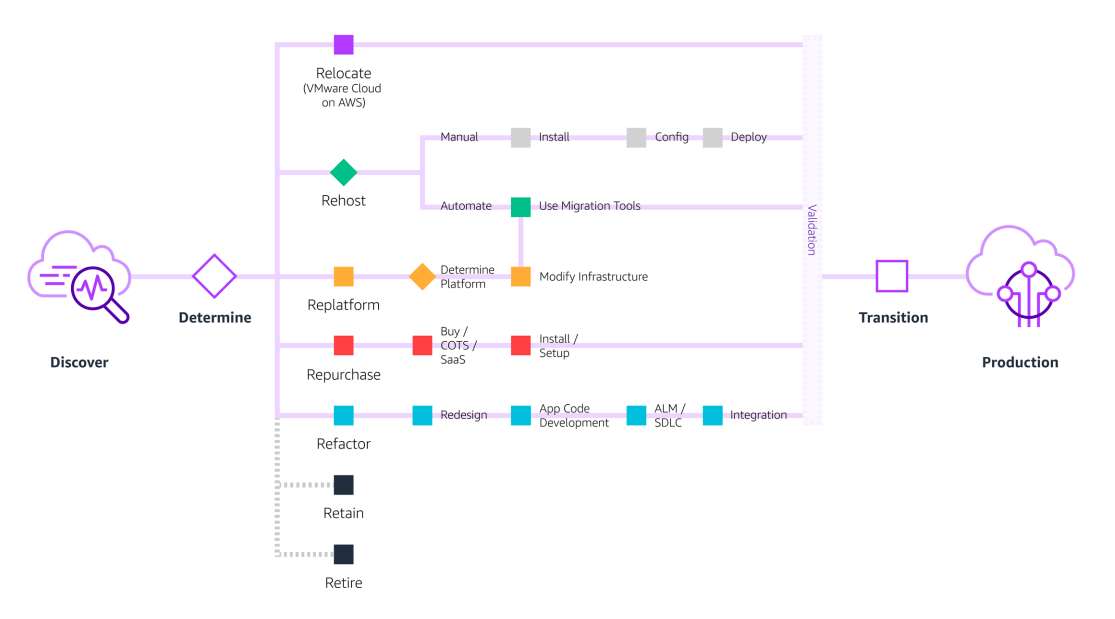Wednesday, 22 January 2020
7 Strategies for Migrating Applications to AWS
This post outlines seven common strategies for migration: "The 7 R's".

# 1. Relocate
> Move vSphere-based applications to AWS without application changes
VMware Cloud on AWS allows you to quickly relocate hundreds of applications virtualised on vSphere to the AWS Cloud in just days and to maintain consistent operations with your VMware Cloud Foundation-based environments.
Once in the AWS Cloud, your applications are easier to optimise or rearchitect to take advantage of the breadth and depth of AWS services
# 2. Rehost
> Also known as “lift-and-shift”
In a large-scale migration scenario where you need to migrate and scale
quickly to meet a business case, such as a data centre lease termination, we find that the majority of applications are rehosted.
Most rehosting can be automated with tools such as CloudEndure Migration,
(from CloudEndure, an AWS company). CloudEndure Migration quickly rehosts
a large number of machines from multiple source platforms (physical, virtual, or another cloud) to AWS without worrying about compatibility, performance disruption, long cutover windows, or long-distance data replications. For times when you can’t install an agent on the server, AWS Server Migration Service offers an agentless service, which makes it easier and faster for you to migrate thousands of on-premises workloads to AWS from a snapshot of the existing servers.
We find that applications are easier to optimise and re-architect once they are already running in the cloud, as your organisation will have developed better skills and can iteratively adopt new technologies (e.g., containers, serverless, etc.) without having to deploy and manage the underlying services.
# 3. Replatform
> Sometimes referred to as “lift-tinker-and-shift”
This entails making a few cloud optimisations in order to achieve tangible benefits, without changing the core architecture of the application. For example, if you’re managing a messaging broker today, you can easily replace this with the fully managed Amazon MQ service, without re-writing your applications or paying for third-party software licenses. Or, if you’re migrating a Windows-based application that requires file storage, you can use the fully-managed Amazon FSx for Windows
File Server. To reduce the amount of time you spend managing database instances, you can move to a database-as-a-service offering such as Amazon Relational Database Service. AWS Database Migration Service makes this re-platforming easier than ever. When moving from one database source or version to a new platform or software version, AWS Database Migration Service keeps the source database fully operational during the migration, enabling near-zero downtime during the cutover.
# 4. Repurchase
> Replace your current environment, casually referred to as “drop and shop”
This is a decision to move to a newer version of the software or purchase an entirely new solution. You may also be looking for a new software licensing model that allows you more flexibility to match your business needs. AWS Marketplace is a curated digital catalog where you can find, buy, deploy, and manage third-party software and services that you need to build solutions and run your business.
# 5. Refactor
> Change the way the application is architected and developed, usually
done by employing cloud-native features
Typically, refactoring (or rearchitecting) is driven by a strong business need to add features, scale, or improve performance that would otherwise be difficult to achieve in the application’s existing environment.
If your organisation is looking to boost agility or improve business continuity by moving to a service-oriented architecture (SOA), this strategy may be worth pursuing—even though it is often the most expensive solution.
# 6. Retain
> Do nothing, for now
You may have portions of your IT portfolio that you are not ready to migrate, or believe are best-kept on-premises. Keep in mind that as more of your portfolio moves to the cloud, allocation of data centre expenses across fewer applications may eventually drive a need to revisit the retained applications.
For applications that remain on-premises, AWS Outposts bring the same hardware and software in the AWS cloud, the same services and APIs, the same management tools, and the same support and operating model to virtually any data centre, co-location space, or on-premises facility. With Outposts, you have a truly consistent hybrid cloud, so that you can develop once and deploy across Outposts on-premises or in the AWS cloud without having to recertify your applications.
# 7. Retire
> Decommission or archive unneeded portions of your IT portfolio
By rationalising your IT portfolio and identifying assets that are no longer useful and can be turned off, you can boost your business case and direct your team’s attention toward maintaining the resources that are more widely used.
Subscribe to:
Post Comments (Atom)
A Fun Problem - Math
# Problem Statement JATC's math teacher always gives the class some interesting math problems so that they don't get bored. Today t...
-
SHA stands for Secure Hashing Algorithm and 2 is just a version number. SHA-2 revises the construction and the big-length of the signature f...
-
## SQRT Decomposition Square Root Decomposition is an technique optimizating common operations in time complexity O(sqrt(N)). The idea of t...
No comments:
Post a Comment